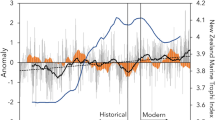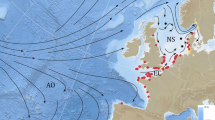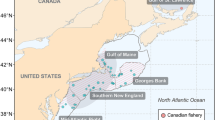Abstract
It has been suggested, on the basis of model simulations and slowly accumulating empirical data, that changes in the structure of marine ecosystems may be caused as much by changes in the trophic levels as by environmental factors1,2. Support for this is found in recently observed shifts in species abundance of North Sea fish stocks, where large catches in the 1970s of small, fast-growing, opportunistic plankton-feeding fishes—sprat, sand eel and Norway pout—have been accounted for as the result of the replacement by these species of depleted herring and mackerel stocks3,4. This suggestion is difficult to confirm, as knowledge of the abundance of these ‘opportunistic’ species since the mid–1960s is largely limited to catch data for the North Sea5. The only sand eel report independent of commercial fisheries catch data is for larvae collected in 1948–68, just before the sharp decline in mackerel and herring stocks6. The area surveyed did not, however, cover all the major population centres in the North Sea. In support of replacement, we describe here evidence from the north–west Atlantic which indicates that population explosions of small, fast–growing sand eel can coincide with depletions of larger tertiary predators, including herring and mackerel in a continental shelf ecosystem. Sand eels serve as an important link in marine food chains, preying on secondary producers and constituting an important food of higher trophic level fish and marine mammals7,8.
This is a preview of subscription content, access via your institution
Access options
Subscribe to this journal
Receive 51 print issues and online access
$199.00 per year
only $3.90 per issue
Buy this article
- Purchase on SpringerLink
- Instant access to full article PDF
Prices may be subject to local taxes which are calculated during checkout
Similar content being viewed by others
References
Steele, J. H. & Frost, B. W. Phil. Trans. R. Soc. B280, 485–534 (1977).
Daan, N. Rapp. P.-v. Réun. Cons. perm. int. Explor. Mer 177, (in the press).
Ursin, E. Cons. int. Explor. Mer C. M. F. 42 (1977).
Andersen, K. P. & Ursin, E. Rapp. P.-v. Réun. Cons. perm. int. Explor. Mer 172, 286–291 (1978).
Hempel, G. Rapp. P.-v. Réun. Cons. perm. int. Explor. Mer 172, 445–449 (1978).
Hart, P. J. B. in The Early Life History of Fish (ed. Blaxter, J. H. S.) 171–182 (Springer, Berlin, 1974).
Bigelow, H. B. & Schroeder, W. C. Fish. Bull. U.S.A. 74, 577 (1954).
Reay, P. J. F.A.O Fish. Biol. Synopses 82 (1970).
Sherman, K. in Advanced Concepts on Ocean Measurements for Marine Biology (eds Diemer, F.P., Vernberg, F. J. & Mirkes, D. Z.) 9–37 (Belle W. Baruch Institute for Marine Biology and Coastal Research, Univ. of S. C. Press, 1980).
Richards, S. W., Perlmutter, A. & McAneny, D. C. Copeia 1963, 358–377 (1963).
Posgay, J. A. & Marak, R. R. J. Northw. Atl. Fish. Sci. 1, 91–99 (1980).
Clark, S. H. & Brown, B. E. Fish. Bull. U.S.A. 75, 1–21 (1977).
Clark, S. H. & Brown, B. E. Investigación pesq. 43, 107–122 (1979).
Grosslein, M., Langton, R. W. & Sissenwine, M. P. Rapp. P.-v. Réun. Cons. perm. int. Explor. Mer 177, (in the press).
Meyer, T. L., Cooper, R. A. & Langton, R. W. Fish. Bull. U.S.A. 77, 243–253 (1979).
Bowman, R. NMFS/NEFC Woods Hole Lab. Ref. No. 80–05 (1980).
Dow, R. L. J. Cons. int. Explor. Mer 37, 274–280 (1977).
Sutcliffe, W. H. J., Drinkwater, K. & Muir, B. S. J. Fish. Res. Bd Can. 34, 19–30 (1977).
Anderson, K. P. & Ursin, E. Medd. Dan. Fish.-Havunder. N.S. 7, 319–435 (1977).
Regier, H. A. & Henderson, H. F. Trans. Am. Fish. Soc. 102, 56–72 (1973).
Mills, E. L. & Fournier, R. O. Mar. Biol. 54, 101–108 (1979).
Cohen, E., Grosslein, M., Sissenwine, M. & Steime, F. Cons. int. Explor. Mer C.M.L. 64 (1980).
Smith, S. H. Bull. Fish. Res. Bd Can. 25, 667–693 (1968).
Beddington, J. R. & Grenfell, B. T. in The Management of the Southern Ocean (eds Mitchell, B. & Sandbrook, R.) 31–40 (International Institute for Environment and Development, London, 1980).
Atchinson, J. J. Am. statist. Ass. 50, 272–901 (1955).
Berrien, P. L., Naplin, N. A. & Pennington, M. R. in The Early Life History of Fish II (eds Lasker, R. & Sherman, K.); Rapp. P.-v. Réun. Cons. perm. int. Explor. Mer 178 (in the press).
Sissenwine, M. P. & Waring, L. L. NMFS/NEFC Woods Hole Lab. Ref. No. 79–12 (1979).
Anderson, E. D. NMFS/NEFC Woods Hole Lab. Ref. No. 80–29 (1980).
Author information
Authors and Affiliations
Rights and permissions
About this article
Cite this article
Sherman, K., Jones, C., Sullivan, L. et al. Congruent shifts in sand eel abundance in western and eastern North Atlantic ecosystems. Nature 291, 486–489 (1981). https://doi.org/10.1038/291486a0
Received:
Accepted:
Issue date:
DOI: https://doi.org/10.1038/291486a0
This article is cited by
-
The burrowing sand lance Ammodytes japonicus (Teleostei, Ammodytidae) prefers benthic sediments of low shear strength
Journal of Ethology (2019)
-
Do surf zones in New Jersey provide “nursery” habitat for southern fishes?
Environmental Biology of Fishes (2013)
-
Marine fisheries as ecological experiments
Theoretical Ecology (2012)
-
Diet of young Atlantic bluefin tuna (Thunnus thynnus) in eastern and western Atlantic foraging grounds
Marine Biology (2011)
-
Science and organization in open-sea research: The plankton
Helgoländer Meeresuntersuchungen (1995)



